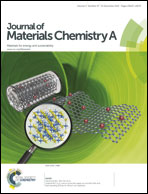Energy gradient architectured praseodymium chalcogenide quantum dot solar cells: towards unidirectionally funneling energy transfer†
Abstract
The energy level alignment of quantum dot solar cells is key to many of the performance characteristics of devices. However, only a few of the quantum dot semiconductor systems have been available thus far, which limits the tunability of both the energy level position and absorption band edge. Here, we present a facile strategy for the first time to prepare a series of praseodymium chalcogenide colloidal quantum dots as alternate light harvesters. By sequentially layering quantum dots, rainbow quadruple-stack junctions with energy gradient architecture are constructed. It is demonstrated that the overall charge transfer time constant from the donor to the acceptor is considerably shortened from 877–1099 to 385 ps, thus leading to a significant enhancement in short-circuit current density (as high as 15.40 mA cm−2) and in power conversion efficiency by over 30% compared to its double-stack counterparts. This work reveals that the formation of the cascade energy level is desirable for robust quantum dot solar cells and concrete evidence has been provided to highlight the role of the energy level in improving photovoltaic performances such as short-circuit current density.


 Please wait while we load your content...
Please wait while we load your content...